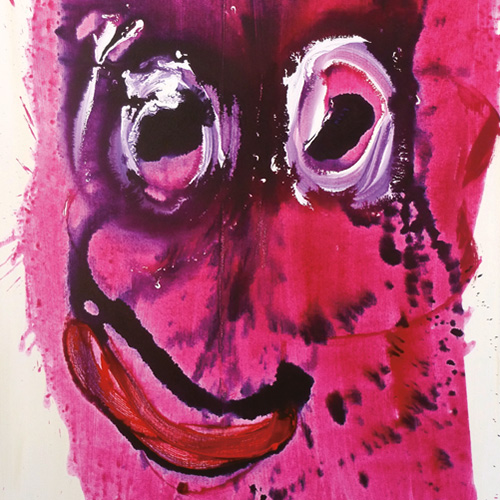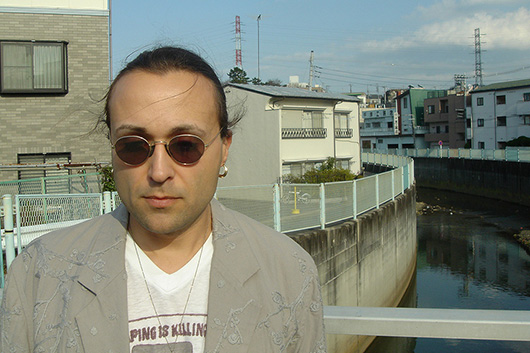Deep Inside: DJ Sprinkles ‘Where Dancefloors Stand Still’
In conversation as well as on record, one doesn’t spend much time with Terre Thaemlitz […]

Deep Inside: DJ Sprinkles ‘Where Dancefloors Stand Still’
In conversation as well as on record, one doesn’t spend much time with Terre Thaemlitz […]

In conversation as well as on record, one doesn’t spend much time with Terre Thaemlitz before finding oneself confronted by their assumptions. This is an unfamiliar kink in the typically well-lubed pipeline of music consumption. In dance music no less than in rock, fandom isn’t free from ideology: we choose our tribal affiliations carefully, but aesthetic preference often obscures a deeper reality of exclusion. As DJ Sprinkles, K-S.H.E., Terre’s Neu Wuss Fusion, G.R.R.L., and many other delightful production aliases, as well as under her own name, the one constant of Thaemlitz’s music is an insistence on a materialist perspective. “I’m very public about the fact that I don’t identify as an artist or a musician,” she tells us. “It’s about cultural production and consumption.” (The producer, who is transgender, refuses to identify with either binary gender identity. However, for clarity’s sake, we will be referring to Thaemlitz using feminine pronouns.) In Thaemlitz’s world, context always trumps notions of essence and authenticity, but that unfashionable—and weirdly disorienting—realism hasn’t prevented her from becoming a kind of dark-horse critical darling in the web era. Her latest release, Where Dancefloors Stand Still, is the first commercial mix CD of Thaemlitz’s 20-plus-year career and will only reinforce that standing—within the online-music-journalism bubble, at least.
Dancefloors‘ deep-house vibes are instantly recognizable as Sprinkles’. Plush and cheap-sounding at the same time, it’s the early-morning, watery-blue sound of Midtown 120 Blues conveyed through other producers’ music. Snares pop like a fingernail flicked against a piece of paper, and pianos and gummy basslines probe into the ether as Sprinkles takes the listener from Carlos Bess waking up in a cold sweat on Sound Mechanix’ “I Can’t Forget” to the unbridled strutting of Gene Ferris’ “Good Feeling.” Here, Thaemlitz doesn’t add voiceovers problematizing your enjoyment of the music, as she did on Midtown 120 Blues, nor is she pushing up against formal expectations as she did on Soulnessless, a mixed-media release, delivered on SD card and containing “the world’s first full-length MP3 album”—a 32-hour piano solo entitled “Meditation on Wage Labor and the Death of the Album.” The mix’s straight-up bodily pleasure is another unpredictable move in a career full of them—not that we should look for some overarching meaning there. “It’s really important to demystify this idea that releases are always part of some teleological path,” Thaemlitz says. “As a producer, you work with different labels with their own schedules. Especially for someone like me, with multiple projects that not only have different names but different styles—when things come out and in relation to what is not always my decision. This is not a follow-up to Soulnessless, even though that’s how things end up getting marketed.”
Where Dancefloors Stand Still

Instead, this collection is an extension of the Deeperama parties Thaemlitz threw between 2003 and 2006 at Club Module in her adopted home of Tokyo. “I was really uptight about DJing dance music,” she says. “The whole fact that I started making music was because my experiences with DJing left me so jaded. I kept getting fired for not playing major-label stuff, for playing instrumental, minor-label stuff.” It took a 10-year hiatus from DJing—from 1993 to 2003— and a move to Japan from the US for a favorable venue to present itself. Her mixing started to change at Module based on the effects and gear they had in the house. Sprinkles’ style is to play tracks from start to finish almost exclusively, honoring each producer’s structural intentions—”It’s very rare for me to mix out before a track gets to the last eight bars or sixteen bars,” she says. It speaks to Sprinkles’ skill as a selector that this “loft-style” mixing never calls attention to itself. Even her generous use of delay hardly distracts from the warm flow; Sprinkles adds just enough to give hi-hat patterns the steady, flanging gust of an oscillating fan, buffeting the listener’s body with warm, human-scented air.
Mule approached Thaemlitz about putting together a mix, and she agreed on the condition of having total control over the track selection. “The thing that was appealing was that it could be in the lines of how I normally DJ in a club,” he said. “I gave them a list of probably 20, 25 tracks that are the main tracks I’ve been playing over the last 10 years. It’s not trying to be clever or obscure, these are really the tracks I play all the time. In the phases where I have regular parties, these are the tracks that would pop up every set basically.” While it may be among the most straightforwardly fun listening experiences Thaemlitz has released, it’s not without a political subtext. Thaemlitz happens to be friends with some of the lawyers who are defending Club Noon in Osaka, which was brought to court for violating Japan’s draconian fuzoku laws around the time the mix was being assembled. “The hope is that if they can get that case overturned, then they have a good chance at overturning these laws,” she says. So when it came time to title the collection, Where Dancefloors Stand Still was a particularly multivalent option. Along with referencing the fact that it consists of DJ Sprinkles’ staple tracks, Thaemlitz says, “Especially outside of Japan, people can have problems with what I play in terms of ‘It’s not fast enough,’ ‘It’s not hard enough,’ so [dancefloors] stand still in that sense too, in terms of my being a kinda shit DJ. It was these jokes together, but the main subtext was about fuzoku laws; in the dance clubs that are left, a lot of them have to have signs that say ‘no dancing.'”

According to Thaemlitz, these laws—which regulate what kinds of establishments can get dance permits, and how spaces with these permits operate—came into effect after World War II, when dance halls were a place for GIs to pick up sex workers. These laws, originally intended to regulate the sex trade and the US military population, were essentially dead on the books for many of the intervening years, without hindering the development of Japanese electronic-music culture. About two or three years ago, the Osaka and Kyoto police started cracking down on clubs for violating these laws, which require clubs to have large, wide-open dancefloors to get a permit; clubs with the hard-to-obtain permit are required to close at 1 a.m. The timing is tricky because the Japanese train system stops at 12:30 a.m. and reopens around 5:30 a.m., meaning that being completely legit in the police’s eyes essentially means strangling a culture that exists between those hours. The reality is twofold: on one side are the places that have dance permits but are technically required to close at 1 a.m. (some of these spots do attempt to stay open past the curfew, prompting police crackdowns), and on the other are clubs that don’t have the permits, simply because most spaces in Japan are not big enough to qualify. (Thaemlitz estimates the required amount of unobstructed undefined dancefloor space at around 125 square meters.)
There has been some pro forma hand-wringing from the police about Yakuza connections and clubs being a bad influence on the country’s youth, but the unexpected reactivation of laws that had been dead on the books for years begs for a more straightforward explanation. “The most logical thing I read was an online comment from a Yokohama-based organizer,” Thaemlitz says of a man whose parties got shut down after years of getting along with the police. “All this trouble started around the same time the government passed this police inspection law, which said that the police had to be accountable for every incident of enforcement of every law on the books. Suddenly, these laws had to formally start showing incident reports, because in order for the police to justify their budgets, they had to show that, for whatever law, they did have incidents. Otherwise, it would look like the police weren’t doing their job, when in fact there’s no job to be done. That to me seems like the most plausible and understandable reason… that it’s just bureaucracy gone amok. There is no weird Moral Majority, Christian bullshit, anti-dancing stuff [in Japan].”

Thaemlitz has found an easier life in Japan than in the West. The producer previously lived in New York and Oakland before relocating to the tiny Kami-Sakunobe district of Kawasaki, located across the Tama River from Tokyo. Still, she’s quick to clarify that the affinity is contextual. “I have social difficulties everywhere—but there are specific things in the culture you grew up in that you internalize, and in the end you say, ‘This must be me.’ There are a lot of things where it’s helpful to have a little cultural distance to say, ‘Oh, there was something about that environment that made itself difficult in ways that were beyond my control.’ I don’t at all romanticize Japan, I’m not ‘into’ Japan in that way. It’s definitely filled with other problems. I have no doubt that if I were born in Japan, I’d want to live elsewhere in the same way that I can’t imagine coming back to the US, having been born there.”
Although Thaemlitz’s music is always some combination of conceptually provocative and politically confrontational, deep house listeners can sink into and ambient electro-acoustic that rubs against the grain, the idea that she’s some kind of renegade academic is a shallow one. For one, it doesn’t acknowledge the mischievous sense of humor lurking just under the surface of the fiery screeds. “I really haven’t done a lot of heavy reading since college,” Thaemlitz says. “In the sense of rigorous study and reading, I have to confess I’m quite stupid.” Her sensibility has been impacted by the sense of social alienation reflected and to some degree created by the techno pop she grew up listening to in Missouri: “Even in the ’90s, within the house scene in the US, I found this resonance to the connection between electronic, non-mainstream music and a position that not only reflected social alienations, but led to other kinds of subcultural alienations.” In college, Thaemlitz found herself in an intellectual environment that was “anti-cultural crit, anti-politics, very high modernist” and becoming involved in activist groups motivated by identity politics. At the same time, Thaemlitz says, there was a lot of thinking around anti-essentialism coming out that complicated this kind of thinking. “The important thing about anti-essentialism is that if you only focus on identity, this idea of advocating for a constructed notion of the self or of the community, then that thing—that image—becomes, in its own construction, exclusionary. When you’re advocating for that image as opposed to, on a more complex level, advocating for social change in relation to problems that arise based on power imbalances between certain readings of identity, that’s a very different way of looking at what the goal of identity politics really is. One is reifying the image of the identity into something that is itself the thing to fight for—pride. The other is about trying to alter the relationships of domination between people within different social spheres.”

This complication ended up leaving Thaemlitz with a precarious relationship to the idea of activism, especially the identity-driven US style. Her approach is to interact with all levels of culture through a critical lens, rather than feeling that analysis is in itself a solution. “The fact that I use analytical language in my commercial audio releases isn’t just about trying to bring critical discourse into the commercial sphere,” she says. “It’s actually a critique of the commercial sphere’s resistance to content, but it’s also a joke on critical analysis—to make it function outside its own self-defined territories, like academia.” This facet of Thaemlitz’s work seems to take a backseat to deep house’s sensuous qualities, but Where Dancefloors Stand Still sports its own ingrained resistance to expectations. For Sprinkles, people these days—especially younger people—are coming into house at a point where it’s an established genre, with codifications and signs pointing to what it should mean. “A lot of these Japanese house DJs have mind-blowing record collections, where every fucking record is a hundred-dollar classic, it’s amazing. But the thing that they’re missing is all the bad records of that era,” she says. “What happens is that everything becomes greater than it was. Histories are constructed through processes of identification and filtering. In retrospect, things come across as much more organized, together, and important than they were. Finding ways to incorporate the unimportant and the forgettable—especially when one’s own sense of relationship to society may be as identifying as the forgotten or forgettable—is important because that act of erasure, invisibility, and forgetting may also be a part of one’s social strategies. It then becomes really important to get away from these ideas of some super-powerhouse DJ set where every track is a classic.”
DJ Sprinkles goes out of her way to point out her own shortcomings, contradictions, and fractures. Still, that hasn’t stopped internet music critics from indulging the anthropological urge—to relate things back to an authentic source, identify patterns of artistic growth, and trace a narrative between releases. The resistance to the kind of content Thaemlitz is intent on bringing to the fore, it seems, is just as strong in the era of torrential free-music downpours as it was in the major-label era, when Sprinkles found herself on the outside of the Sally’s Hideaway circle because she didn’t play Gloria Estefan records. Where Dancefloors Stand Still is not out to prove or say anything in particular, but for anyone with doubts about such smartypants stuff, it shows that the commitment to a materialist reading of culture goes hand in hand with an off-the-cuff, lived-in brilliance. More importantly, it demonstrates that being tenaciously committed in the less-than-accommodating music game can also happen to result in putting together a superlative, big-hearted collection like this one.

